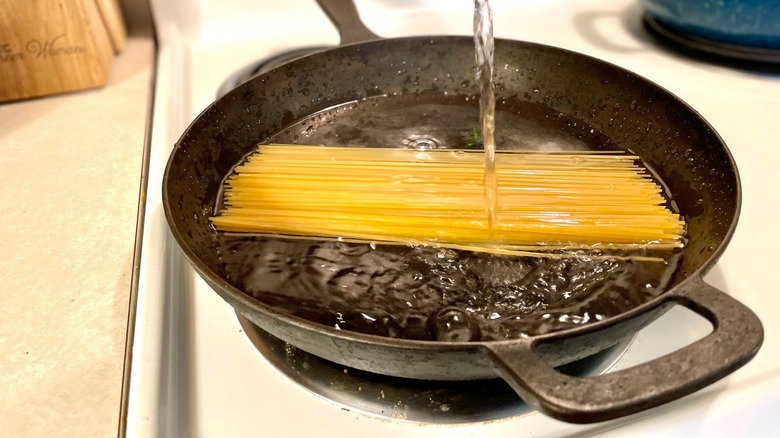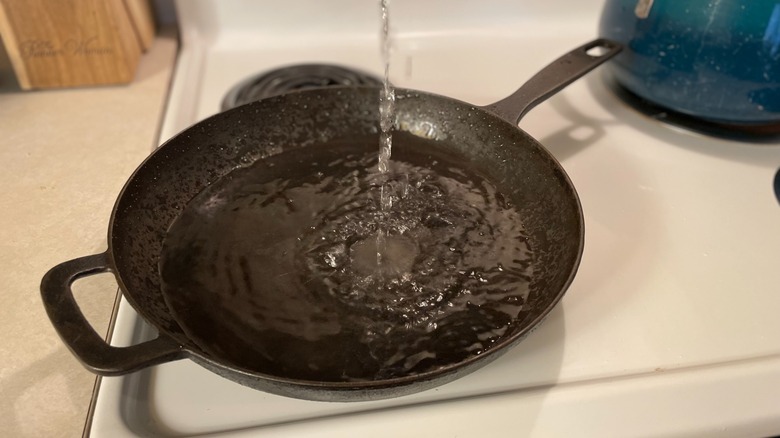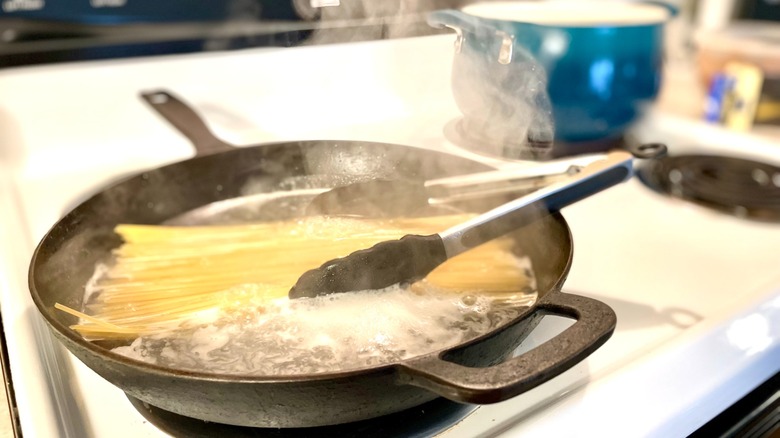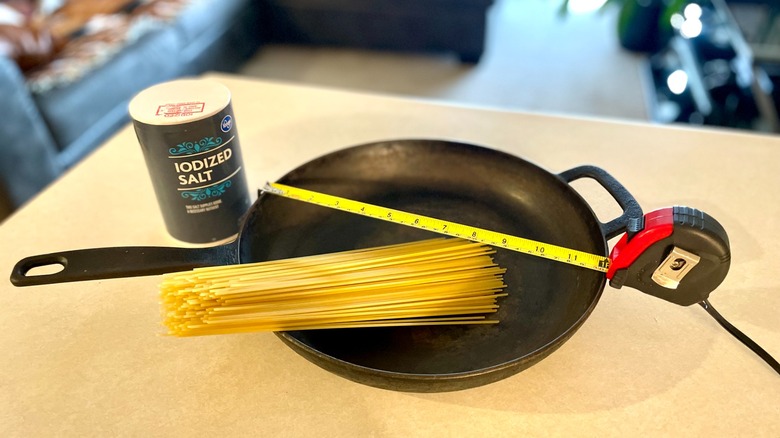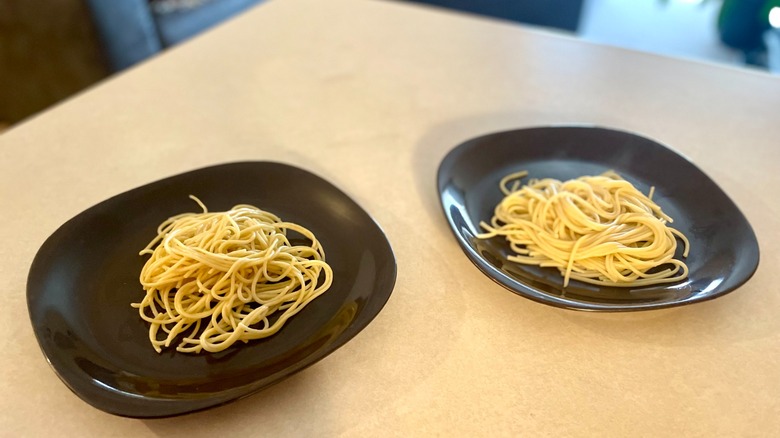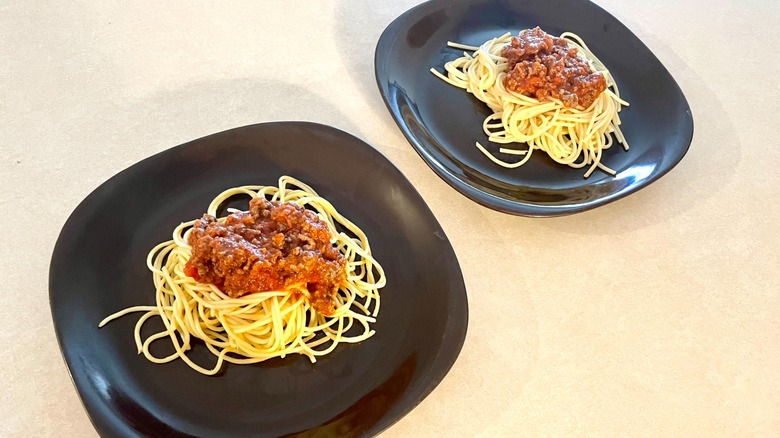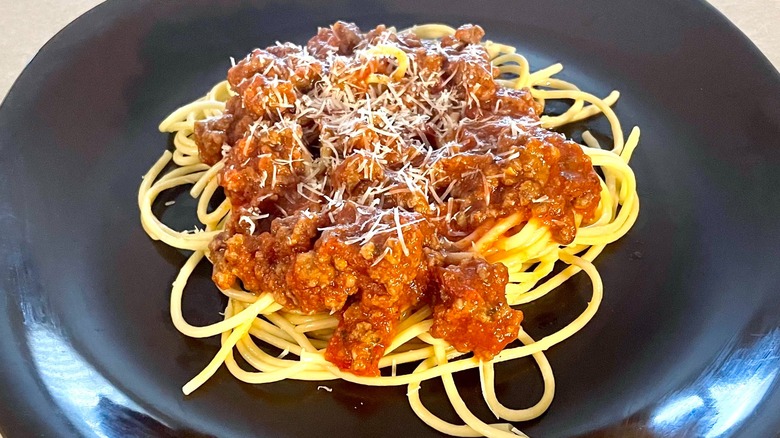What Is The Cold Water Pasta Hack And Does It Work?
Cooking pasta using cold water? Count me in ... or so I thought. The cold water pasta hack has people in quite a tizzy and, being the pasta-making machine I am, I couldn't help but be intrigued. When presented with the opportunity, I jumped at the chance to try it, interested to see whether this really could be a newer and better way to make pasta. So what did I discover? A lot, actually.
I'll take you through the ins and outs of the cold water hack (one of many pasta cooking hacks out there) and how it pans out when it comes to cooking in a real kitchen. Let's face it, not everything posted on the internet is always what it seems, and most of us would rather not waste our precious resources taking on cooking techniques that are destined to fail. Join me as I put the cold water pasta hack to the test and share my final thoughts on whether this "hack" is worth your time to begin with.
What is the cold water pasta hack?
I first want to start by describing what this hack is not. If you're anything like me, you looked at the title of this hack and thought, "Oh, goodie, I can make pasta without having to turn on my stove." As wonderful as that would be, that isn't exactly what the cold water pasta method is. Allow me to explain.
Per America's Test Kitchen's Instagram, the cold water pasta hack involves several steps. First and foremost, you'll need 1 quart of cold water. You'll then want to place this cold water in a 12-inch skillet (or large saucepan) along with 8-16 ounces of pasta. Add 1 ½ teaspoons of salt and bring to a boil before stirring and reducing heat. Allow the noodles to simmer. Continue to cook the noodles until they're done according to your desired level of tenderness.
After stating the proposed steps, America's Test Kitchen went on to make some pretty bold claims. Supposedly, this method is the preferred way to cook pasta according to culinary experts and requires less cooking time and less water to achieve. In fact, America's Test Kitchen asserts that your noodles can cook up to 45% faster this way, practically cutting noodle prep time in half. Needless to say, this hack needed to be tested. I couldn't wait to see whether these claims were actually true.
How hot does the water need to be?
The water needs to be boiling. I repeat — the water must boil. Remember that the cold water hack isn't a technique that forgoes the use of heat. The water still needs to be brought to a boil for the noodles to cook. The cold water only comes into play at the beginning, as you place the noodles in the skillet with cold water before turning on the heat. Even so, don't feel like you need to keep your stove on high temp the entire time; according to America's Test Kitchen, you'll need to reduce the heat to a simmer once the water comes to a boil.
Be advised that although bringing the water to a boil is the recommended (and very necessary) procedure, it isn't foolproof. You'll soon see why this boiling water can sometimes cause an issue when using the cold water method, but I'll unpack that more later.
What supplies do you need?
To determine whether this hack works, I tried to make sure I followed America's Test Kitchen's prescribed approach as closely as possible. I used a 12-inch skillet, 8 ounces of noodles per cooking method (one for the cold water hack and the other 8 ounces for a pot of traditional boiled noodles), salt, and, of course, water. Later, I found it necessary to have tongs on hand, so I'd recommend grabbing those as well.
For the taste test, I ladled a heaping serving of sauce made of ground beef and Prego (classy, I know) over both the cold water pasta and boiled noodles. I did not use a colander to drain the noodles because I learned long ago that keeping noodles starchy helps the sauce cling (it's important to save some of the pasta water). So for each taste test, I used noodles pulled straight from the water — no rinsing or draining required.
Does the cold water hack actually work?
Kind of? If I'm being totally honest, the process was kind of a nightmare. I kept going back to the instructions to see what I was doing wrong, but I really think the nature of this cooking method lends itself to a bit of a headache.
So what was so frustrating about the cold water hack? Several things. First, once your water begins to heat up, it's important to start stirring your noodles right away. To be fair, America's Test Kitchen instructs you to start stirring the moment you see steam, and I'm here to tell you they are absolutely right. Not only should you stir right away, but you should keep stirring to keep your noodles from clumping together and sticking to the pan.
The second issue is the boiling water. Since you're bringing a quarter of the amount of water you'd normally use to a boil in a shallow skillet, the water evaporates rather quickly. And before you say it, I did reduce the heat after it started boiling. It made no difference. Thus, I was left with no choice but to add another cup of water to the noodles; otherwise, I would have been stuck with hard inedible pasta. For this reason, I struggle to say that this hack works as written — it needs a bit of tweaking to produce noodles you can actually eat.
How does cold water pasta taste when compared to the traditional boiling method?
The cold water pasta finally started softening after I added another cup of water. In total, I had to cook the noodles for about 14 minutes start to finish before they became al dente and soft enough to eat. My traditional boiled noodles took about 20 minutes to cook; thus, the cold water hack was definitely faster.
The first thing I noticed when eating the cold water noodles was that they were salty — very salty. But once sauced, the saltiness of the noodles faded and was suddenly less noticeable. Actually, it was rather tasty. The cold water noodles ended up having a firm yet soft bite that served as an excellent base for sauce. With that in mind, I went in for a taste of the traditionally boiled noodles, and the difference was night and day. For reference, I cooked the traditional noodles according to the package directions and made sure they were also al dente for a fair comparison.
I was taken aback at how bland, spongy, and flavorless the traditional boiled noodles now tasted — especially since they were noodles that I was most accustomed to eating. They came off as unbearably mundane and the texture felt a bit slimy; it was so weird. I realized then and there that the cold water pasta hack does produce better results; it's just that the procedure might need a bit of tweaking to get it right.
Final thoughts
Is the cold water hack worth trying? Yes, it is — but with caveats. First of all, always make sure there's enough water in your skillet. Though America's Test Kitchen recommends only 4 cups, I think that's a bit of a lowball. In actuality, you'll probably need to replenish the water at least once, especially if you choose to boil 16 ounces worth of pasta at once. Just be sure to only add the amount you actually need to get the noodles boiled; adding water unnecessarily will likely only yield results similar to what you'd get from a traditional boiling method.
Next, I suggest you cut back on salt a bit, depending on the recipe you'll use your noodles for. If you're making this cold water pasta and plan to add salty cheese or a well-seasoned sauce, you'll want to use less than 1 ½ teaspoons of salt to the water. Trust me, you can taste the salt, and if the topping you're adding to the noodles is already salty, you'll end up with an inedible dish.
Finally, remember that cooking your noodles using cold water will take some time, though not quite as long as boiling them the traditional way. All in all, I will certainly try the cold water pasta hack again, simply because I really enjoyed the texture and flavor of the noodles. It makes for an awesome foundation for sauce and could upgrade your next pasta dish.
